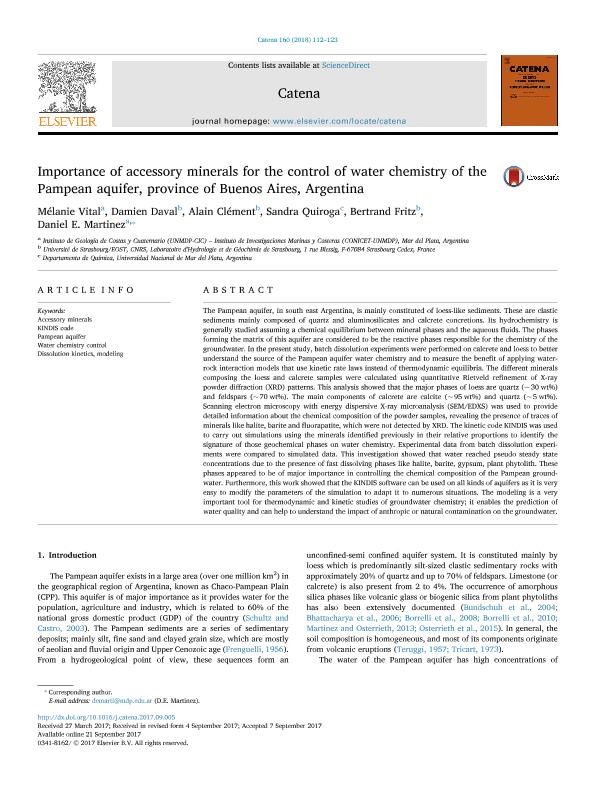Mostrar el registro sencillo del ítem
dc.contributor.author
Vital, Mélanie

dc.contributor.author
Daval, Damien
dc.contributor.author
Clément, Alain
dc.contributor.author
Quiroga, Sandra Lujan

dc.contributor.author
Fritz, Bertrand
dc.contributor.author
Martinez, Daniel Emilio

dc.date.available
2019-10-22T12:21:06Z
dc.date.issued
2018-01
dc.identifier.citation
Vital, Mélanie; Daval, Damien; Clément, Alain; Quiroga, Sandra Lujan; Fritz, Bertrand; et al.; Importance of accessory minerals for the control of water chemistry of the Pampean aquifer, province of Buenos Aires, Argentina; Elsevier Science; Catena; 160; 1-2018; 112-123
dc.identifier.issn
0341-8162
dc.identifier.uri
http://hdl.handle.net/11336/86803
dc.description.abstract
The Pampean aquifer, in south east Argentina, is mainly constituted of loess-like sediments. These are clastic sediments mainly composed of quartz and aluminosilicates and calcrete concretions. Its hydrochemistry is generally studied assuming a chemical equilibrium between mineral phases and the aqueous fluids. The phases forming the matrix of this aquifer are considered to be the reactive phases responsible for the chemistry of the groundwater. In the present study, batch dissolution experiments were performed on calcrete and loess to better understand the source of the Pampean aquifer water chemistry and to measure the benefit of applying water-rock interaction models that use kinetic rate laws instead of thermodynamic equilibria. The different minerals composing the loess and calcrete samples were calculated using quantitative Rietveld refinement of X-ray powder diffraction (XRD) patterns. This analysis showed that the major phases of loess are quartz (~ 30 wt%) and feldspars (~ 70 wt%). The main components of calcrete are calcite (~ 95 wt%) and quartz (~ 5 wt%). Scanning electron microscopy with energy dispersive X-ray microanalysis (SEM/EDXS) was used to provide detailed information about the chemical composition of the powder samples, revealing the presence of traces of minerals like halite, barite and fluorapatite, which were not detected by XRD. The kinetic code KINDIS was used to carry out simulations using the minerals identified previously in their relative proportions to identify the signature of those geochemical phases on water chemistry. Experimental data from batch dissolution experiments were compared to simulated data. This investigation showed that water reached pseudo steady state concentrations due to the presence of fast dissolving phases like halite, barite, gypsum, plant phytolith. These phases appeared to be of major importance in controlling the chemical composition of the Pampean groundwater. Furthermore, this work showed that the KINDIS software can be used on all kinds of aquifers as it is very easy to modify the parameters of the simulation to adapt it to numerous situations. The modeling is a very important tool for thermodynamic and kinetic studies of groundwater chemistry; it enables the prediction of water quality and can help to understand the impact of anthropic or natural contamination on the groundwater.
dc.format
application/pdf
dc.language.iso
eng
dc.publisher
Elsevier Science

dc.rights
info:eu-repo/semantics/openAccess
dc.rights.uri
https://creativecommons.org/licenses/by-nc-nd/2.5/ar/
dc.subject
ACCESSORY MINERALS
dc.subject
DISSOLUTION KINETICS, MODELING
dc.subject
KINDIS CODE
dc.subject
PAMPEAN AQUIFER
dc.subject
WATER CHEMISTRY CONTROL
dc.subject.classification
Geoquímica y Geofísica

dc.subject.classification
Ciencias de la Tierra y relacionadas con el Medio Ambiente

dc.subject.classification
CIENCIAS NATURALES Y EXACTAS

dc.title
Importance of accessory minerals for the control of water chemistry of the Pampean aquifer, province of Buenos Aires, Argentina
dc.type
info:eu-repo/semantics/article
dc.type
info:ar-repo/semantics/artículo
dc.type
info:eu-repo/semantics/publishedVersion
dc.date.updated
2019-10-21T18:23:15Z
dc.journal.volume
160
dc.journal.pagination
112-123
dc.journal.pais
Países Bajos

dc.journal.ciudad
Amsterdam
dc.description.fil
Fil: Vital, Mélanie. Consejo Nacional de Investigaciones Científicas y Técnicas. Centro Científico Tecnológico Conicet - Mar del Plata. Instituto de Investigaciones Marinas y Costeras. Universidad Nacional de Mar del Plata. Facultad de Ciencias Exactas y Naturales. Instituto de Investigaciones Marinas y Costeras; Argentina
dc.description.fil
Fil: Daval, Damien. Université de Strasbourg; Francia
dc.description.fil
Fil: Clément, Alain. Université de Strasbourg; Francia
dc.description.fil
Fil: Quiroga, Sandra Lujan. Universidad Nacional de Mar del Plata; Argentina. Consejo Nacional de Investigaciones Científicas y Técnicas; Argentina
dc.description.fil
Fil: Fritz, Bertrand. Université de Strasbourg; Francia
dc.description.fil
Fil: Martinez, Daniel Emilio. Consejo Nacional de Investigaciones Científicas y Técnicas. Centro Científico Tecnológico Conicet - Mar del Plata. Instituto de Investigaciones Marinas y Costeras. Universidad Nacional de Mar del Plata. Facultad de Ciencias Exactas y Naturales. Instituto de Investigaciones Marinas y Costeras; Argentina
dc.journal.title
Catena

dc.relation.alternativeid
info:eu-repo/semantics/altIdentifier/url/https://www.sciencedirect.com/science/article/pii/S034181621730293X
dc.relation.alternativeid
info:eu-repo/semantics/altIdentifier/doi/http://dx.doi.org/10.1016/j.catena.2017.09.005
Archivos asociados
